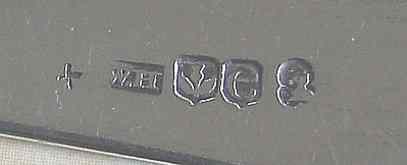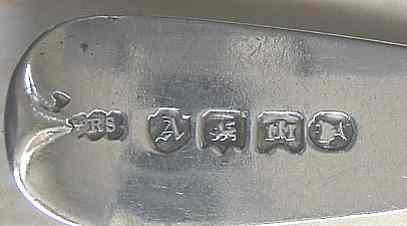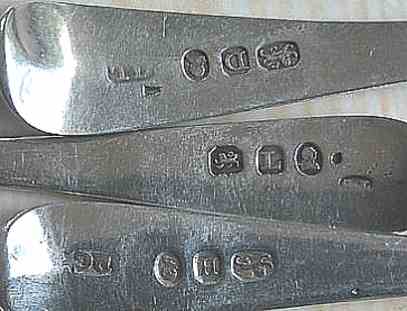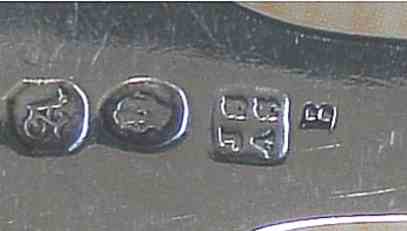
ASSOCIATION OF SMALL COLLECTORS OF ANTIQUE SILVER
ASCAS
| article # 195 |
|
|
|
|
(click on photos to enlarge image)
JOURNEYMEN'S MARKS
Anyone interested in English silver flatware of
the late 18th and early 19th centuries will not fail to have
noticed what appear to be damage marks near the hallmarks. These
are marks which appear on London flatware, although they can be
seen on flatware assayed at other offices (Figs I a&b), about
which very little is known at present. These marks are
Journeymen's marks.Such a mark is the identifying mark of the actual workman who made the piece and who was employed by the "maker" (now sponsor) whose mark must appear by law and is registered at Goldsmiths Hall. No such register was kept for journeymen and the matter of establishing who worked for whom is an area of research still waiting to be undertaken. These journeymen were craftsmen who had been made free of a Livery Company having completed a term of apprenticeship under the guidance of a master goldsmith and were thus qualified to practice their craft. However to set up a workshop was an expensive undertaking and a young man newly qualified was unlikely to have the necessary finance for such an undertaking until he had worked in an established workshop for some time. Commonly it would take at least two years for such a young craftsman to acquire enough finance to set up his own workshop and sometimes he would do so in partnership with a fellow apprentice. It was not uncommon however for a newly qualified goldsmith to marry his Master's daughter and thus gain a partnership in the workshop in which he had done his training. For this reason it may eventually be shown that some journeymen's marks had a short lifespan. It should be said that these marks are found only on flatware and first appear after the introduction of top marking in 1781, the earliest I know of is on a piece dated 1785, and took the form of blemishes such as dots, crosses, crescents, hearts etc. (Fig II). They were punched into the silver next to, and sometimes incorporated with, the makers mark. Some were quite obviously impressed with a properly engraved punch while others appear to have been created by merely "damaging" the piece in some way with any steel tool or point. These marks must not be confused with the broad arrow which appears near the hallmarks on some flatware of this period and punched quite deeply into the silver. These marks indicate that such flatware was originally in issue to the officer class of the Royal Navy. By the end of the first quarter of the 19th. century alphabetical letters were appearing on flatware associated with the workshop of Joseph and Albert Savory and these were presumably the workman's initial. The upper case letter "B", Fig III is an example and I have also observed the upper case letter "F" and the upper case letter "S". This practice may have been adopted by other workshops. It is possible to see a complete service of flatware of this period bearing the same Journeyman's mark but it is more usual to see from these marks that more than one Journeyman was involved in producing a service of flatware. As not all flatware carries these marks, presumably because not all makers employed journeymen or perhaps the practise was not universally used in all workshops, it is difficult to determine exactly when these marks first came into use and when they died out although I have not found them on bottom marked flatware and they certainly persisted at least into the second half of the 19th Century. The practice has been now revived in the modern firm of Stuart Devlin (see note 1). Although the term journeyman means "Day Worker" and thus implies that the Journeyman would have been employed on a casual or short term basis it seems likely that this was not the case and that a Journeyman may have worked in the same workshop all his life. His mark, therefore, is peculiar to one particular workshop and identifies him with one particular maker. This could be confusing as the same mark, and more especially the same initial, may have been used by more than one man and, for identification purposes, would have to be read in conjunction with the makers mark. Conversely, if a particular mark or initial could be identified with one particular journeyman that mark could assist in attribution in cases where the maker's mark is "rubbed" since the Journeyman's mark was often struck quite deeply and is more likely to have survived. One might reasonably attribute an item of flatware of the mid 19th century stamped with the upper case letters "B", "F" or "S" to J.& A. Savory even if the maker's mark was rubbed! Fig III)
NOTE 1) Ian Pickford - SILVER FLATWARE English, Irish and Scottish -1660-1980 - p44
|



